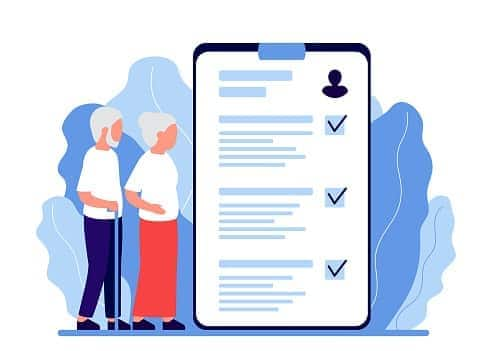What is Medicare?
Medicare is a federal health insurance group health coverage program that's the single largest payer of health insurance in the country.
Who qualifies for Medicare? People become eligible when they turn 65. It’s also available for people under 65 with disabilities or those with end-stage renal disease or amyotrophic lateral sclerosis (ALS).
Total Medicare enrollment is more than 63 million people, according to the U.S. Centers for Medicare & Medicaid Services.
What does Original Medicare cover?
Medicare health insurance is divided into four parts:
- Medicare Part A: Covers inpatient hospital care, some skilled nursing facility care, hospice care, and home health care in some cases.
- Medicare Part B: Part B coverage handles doctor visits, outpatient services, medical supplies, durable medical equipment, and preventive services. Parts A and B comprise Original Medicare.
- Medicare Part C: Part C is also called Medicare Advantage and is an alternate form of Original Medicare coverage in which private insurance companies offer plans that can include prescription drug coverage. Medicare Advantage plans must include the same minimum coverage as Original Medicare.
- Medicare Part D: Part D coverage is often paired with Part A and/or Part B and provides Medicare prescription drug coverage
What isn’t covered in Original Medicare?
Original Medicare, sometimes called traditional Medicare, doesn’t cover some health-related services. These include:
- Long-term care
- Most dental care
- Eye exams related to prescribing glasses
- Dentures
- Cosmetic surgery
- Most types of acupuncture
- Hearing aids and exams for fitting them
- Routine foot care
The government’s official Medicare website offers a tool that can help you find out if your test, item or service is covered.
Who qualifies for Medicare?
Once you turn 65, you’re eligible for Medicare. Older people make up the vast majority of Medicare enrollees. According to CMS, most people can get Part A (hospital insurance) for free, but some may have to pay a premium for this coverage. See the eligibility requirements for Part A on the CMS.gov website here.
However, there are situations where younger people are eligible for Medicare. Those under the age of 65 are eligible for Part A without paying premiums if they receive Social Security or Railroad Retirement Board disability benefits for 24 months or if they are being treated for kidney dialysis, kidney transplant or permanent kidney failure.
Younger patients with ALS -- Lou Gehrig’s disease -- are also eligible for Medicare benefits in the first month of disability benefits. This means they don’t have to wait for 24 months to get Medicare coverage.
How does Medicare work?
Medicare is divided into Parts A, B, C and D. Original Medicare consists of Parts A (hospital insurance) and Part B (medical insurance).
“A common misconception about Original Medicare is that it pays for everything when in reality it does not,” Ciano says.
For example, Original Medicare doesn’t cover prescription drugs, vision, dental or hearing care. If you have Original Medicare and need help paying prescription drug costs, you need to buy a Part D plan.
“It also does not cap your annual out-of-pocket spending for medical care, which means there’s no limit to the expenses you may have to pay each year for your medical services,” Ciano says.
Medicare Advantage plans -- Part C -- are offered by private insurance companies through a contract with the federal government. These plans can also include prescription drug coverage and extra benefits like dental, vision, hearing care and/or fitness programs.
“One of the biggest benefits of a Medicare Advantage plan is that it caps out-of-pocket spending,” Ciano says.
There are four types of Medicare. These plans cover specific services:
| Type | What it covers | What it costs |
|---|---|---|
| A (hospitals) | Inpatient hospital, some skilled nursing facility care, hospice care, home health care in some cases | Free for nearly all Americans. One reason why you might have to pay a premium is if you didn’t pay Medicare taxes for at least 40 quarters. If you must pay a premium, it costs up to $505 monthly. Part A has a $1,632 deductible for each benefit period. |
| B (Medica) | Doctor visits, outpatient care, medical supplies, preventive services | Part B costs $174.70 monthly, but could be more than double that amount depending on income. The annual deductible is $226. After you reach the deductible, you're responsible for 20% of the costs. |
| C (Medicare Advantage) | Medicare plans through private insurance companies and can also offer prescription drug coverage | Medicare Advantage premiums vary based on coverage. Deductibles vary by plan, but they're often much higher than Part B deductibles. |
| D (prescription drugs) | Prescription drug coverage | The Part D monthly premium varies by plan (higher-income consumers may pay more) |
How to sign up for Medicare
Wondering how to apply for Medicare? If you are not automatically enrolled in Medicare and need to apply, you can get in touch with a Social Security Administration office or fill out an application online on the Social Security website. If you worked for the railroad, contact the Railroad Retirement Board.
If you have questions about Medicare eligibility or enrollment, call Social Security's toll-free number, 1-800-772-1213 or visit the Social Security website.
Learn more about how to sign up for Medicare.
When to apply for Medicare
You receive sign-up instructions once your Medicare enrollment period begins, which is three months before the month of your 65th birthday. Those with qualifying disabilities such as end-stage renal disease or ALS may sign up for Medicare before turning 65.
The enrollment period lasts for seven months. If you miss your initial enrollment, you need to wait until the annual Medicare Annual Enrollment period, from October 15 to December 7 each year or wait for a special enrollment period to occur. Note that you can only sign up for Medicare Advantage plans during Medicare Annual Enrollment if you are already enrolled in Original Medicare.
If you receive Social Security or Railroad Retirement Board benefits, you’re automatically enrolled in Medicare Part A and Medicare Part B when you turn 65 but can choose Medicare Advantage instead.
Medicare vs. Medicaid
Both Medicare and Medicaid are both through the Centers for Medicare and Medicaid Services.
Medicare is an insurance program that primarily covers the health bills of those who are 65 and older and for those younger than 65 with qualifying disabilities such as end-stage renal disease or ALS. You don’t need to meet income requirements to qualify for Medicare, but you’re required to pay some of the costs when you receive care.
Meanwhile, Medicaid coverage is an assistance program that serves low-income people regardless of age and those with qualifying disabilities. Patients typically aren’t responsible for expenses associated with covered medical expenses, although co-payments may be required.
People may qualify for both Medicare and Medicaid services, which is called being dual eligible. In that case, the two insurance programs will work together to pay for your health care.
How much does Medicare cost?
Medicare program costs vary and often change. Most people don’t pay a premium for Part A.
There’s no Part A premium as long as you paid Medicare taxes for at least 40 quarters. If you didn’t pay enough taxes, you must pay a monthly premium, which is $505 in 2024.
There is also a $1,632 inpatient hospital deductible for Part A per benefit period. Coinsurance begins during days 61 and 90 ($408 per day of each benefit period) when hospitalized.
Days 91 and beyond are $816 per each "lifetime reserve day" after day 90 for each benefit period up to 60 days over your lifetime.
Once you go beyond lifetime reserve days (after day 150) on Part A, you’re responsible for all costs.
The Part B premium is $174.70, or higher, depending on income. The Part B deductible is $226. Once you meet the deductible, you typically pay 20% of the Medicare-approved amount.
Both Part C and Part D premiums vary by plan.
Also, remember that other costs may apply that go beyond premiums.
“If you choose an out-of-network provider, you may have to pay higher out-of-pocket costs,” Ciano says.
Medicare Advantage and Part D plans and benefits offered by the following carriers: Accendo, ACE-Chubb, Aetna Medicare, AFLAC, Allstate - National General, Anthem Blue Cross Blue Shield, Aspire Health Plan, Capitol, Centene Corporation, Cigna-HealthSpring, Dean Health Plan, Devoted Health, GlobalHealth, Health Care Service Corporation, Humana, Lumico - Elips, Manhattan Life - MAC, Molina Healthcare, Mutual of Omaha, Oscar Health Insurance, Premera Blue Cross, Medica Central Health Plan, SCAN Health Plan, Scott and White Health Plan now part of Baylor Scott & White Health, UnitedHealthcare®
Source:
- Medicare.gov. Costs, Accessed August 2022.
Disclaimer:
Insurance.com is not affiliated with or endorsed by the government or Federal Medicare program. Plans are insured or covered by a Medicare Advantage organization with a Medicare contract and/or a Medicare approved Part D sponsor. Enrollment in the plan depends on the plan’s contract renewal with Medicare. We do not offer every plan available in your area. Currently we represent 10 organizations which offer 100 products in your area. Please contact Medicare.gov, 1800-MEDICARE, or your local State Health Insurance Program (SHIP) to get information on all of your options. Not all plans offer all of these benefits. Benefits and availability may vary by carrier and location. Limitations and exclusions may apply. Every year, Medicare evaluates plans based on a 5-star rating system. Part B Premium give-back is not available with all plans. Actual Part B premium reduction could be lower. Deductibles, copays and coinsurance may apply. Enrollment in the described plan type may be limited to certain times of the year unless you qualify for a Special Enrollment Period.
MULTIPLAN_ICOMGETCOV0125_C
Health insurance finder tool

COBRA
Learn more about COBRA
Medicare
Medicare costs vary depending on which option you choose.
Learn more about Medicare costs.
Medicaid

Parent's employer-sponsored health insurance

Spouse's employer-sponsored health insurance

Employer-sponsored health insurance

Preferred-provider Organization (PPOs)
Preferred-provider organization (PPOs) plans are the most common type of
employer-based health plan. PPOs have higher premiums than HMOs and HDHPs, but
those added costs offer you flexibility. A PPO allows you to get care anywhere
and without primary care provider referrals. You may have to pay more to get
out-of-network care, but a PPO will pick up a portion of the costs.
Find out more about the differences between plansHealth maintenance organization (HMO)
Health maintenance organization (HMO) plans have lower premiums than PPOs.
However, HMOs have more restrictions. HMOs don't allow you to get care outside
of your provider network. If you get out-of-network care, you'll likely have to
pay for all of it. HMOs also require you to get primary care provider referrals
to see specialists.
Find out more about the differences between plansHigh-deductible health plans (HDHPs)
High-deductible health plans (HDHPs) have become more common as employers look
to reduce their health costs. HDHPs have lower premiums than PPOs and HMOs, but
much higher deductibles. A deductible is what you have to pay for health care
services before your health plan chips in money. Once you reach your deductible,
the health plan pays a portion and you pay your share, which is called
coinsurance.
Find out more about the differences between plansExclusive provider organization (EPO)
Exclusive provider organization (EPO) plans offer the flexibility of a PPO with
the restricted network found in an HMO. EPOs don't require that members get a
referral to see a specialist. In that way, it's similar to a PPO. However, an
EPO requires in-network care, which is like an HMO.
Find out more about the differences between plans
Learn more about individual insurance plans
Frequently asked questions about Medicare
How do you find a doctor who accepts Medicare?
One of your biggest concerns with switching health insurance might be: Will I get to keep my doctor?
If you have Medicare or sign up for Medicare, an easy way to find a doctor or to see if your current doctor accepts Medicare is to check the CMS comparison tool. The tool lets you search by the provider’s name or the group practice name. You can also look by specialty, medical condition, body part or organ system. That will help you find specialists.
Do I need a Medicare plan when I turn 65?
You don't have to sign up for Medicare at 65. However, it might be a wise idea to at least get Part A -- since it's likely free and does not have a premium. The Medicare tax through payroll taxes helps pay for that Medicare program.
So, even if you have another health plan that you like, you can still sign up for Part A, which can help with hospitalization costs. Medicare and other insurers have something called coordination of benefits (COB). COB figures out which plan pays first for coverage if you have more than one plan.
How do I find a Medicare plan?
Not too long ago, people turned 65 and could only enroll in Original Medicare (Parts A and B). Now, qualifying consumers have multiple options, including Medicare Advantage.
You can go with Parts A and B, you can add on a Part D plan or you can choose one of many Medicare Advantage offerings.
You’re able to compare plans each year and pick the best one for you. Medicare recommends members consider:
- Costs
- Coverage
- Your other coverage
- Prescription drugs
- Doctor and hospital choice
- Quality of care
- Travel
You also want to make sure your doctors or hospital are considered in-network. You might even want unrestricted access and not need doctor referrals. In that case, you might want to get a PPO, which is more expensive than an HMO but gives you more flexibility.
One way to figure out the plan for you is to check out CMS’ star ratings for the different plans. CMS rates plans between one and five stars, with five stars being the highest mark. The ratings take into account membership surveys, quality and performance.
Besides the prestige of earning five stars, health insurance companies get a higher reimbursement from the government when they have a five-star plan.
The Medicare website has a plan finder that lets you compare Medicare plans in your area. The site asks a series of questions that help narrow the number of plans of interest. It reveals each plan that may make sense for you, including Medicare premiums, deductibles, estimated annual health and drug costs and overall rating.
Once you find the plan for you, you can choose it on the site and fill out the necessary paperwork.
Should you choose Original Medicare or Medicare Advantage?
Which Medicare works best depends on your situation, your area, provider networks, and what plans are available.
For example, you can stick with Original Medicare (Parts A & B) if you want to keep your current doctor who doesn’t accept Medicare Advantage and the plan has better overall coverage than Medicare Advantage.
A Medicare Advantage plan can make sense if you want medical and drug coverage combined into one plan, hope to limit annual out-of-pocket costs, and want to get extra benefits like dental, vision and hearing.
Does Medicare cover acupuncture?
Yes, Medicare covers acupuncture -- but only for chronic lower back pain.
In those circumstances, Medicare covers up to 12 acupuncture visits in 90 days. If you show improvement as a result of the treatment, Medicare may cover an additional eight sessions.
Medicare stops covering treatments if your doctor says the acupuncture isn’t improving your condition. You’re limited to 20 acupuncture treatments annually.
When can I change Medicare plans?
All Medicare beneficiaries can switch plans once a year. This happens during Annual Enrollment Period or AEP. Medicare’s Annual Enrollment Period runs between October 15 and December 7. Any changes will take effect on January 1.
During that time, you can switch Medicare Advantage plans, change from Medicare Advantage to Original Medicare, swap Original Medicare for Medicare Advantage or change Part D plans.
There's another open enrollment period from January 1 to March 31, but it's limited to only switching Medicare Advantage plans or moving from Medicare Advantage to Original Medicare. Only one change can be made during this period.
However, Medicare beneficiaries can also make changes during any time of the year if they go through certain life events. That can include if you move or you lose other health insurance coverage.
Here are some events that trigger a special enrollment
- Loss of coverage
- Changes in residence, such as moving out of a plan's coverage area
- Changes to your income
If you go through an eligible life event, you can make changes during a special enrollment period. Changes made during a special enrollment period usually kick in on the first day of the next month.
What is Supplement Insurance (Medigap)?
Medicare, just like any health insurance, can get pricey. Medigap is one way to help you pay for out-of-pocket health care costs.
Medigap is Medicare supplement insurance for those with Original Medicare. Medigap kicks in after Medicare pays its amount for covered healthcare services.
Original Medicare pays for 80% of your medical needs. Medigap can cover the remaining 20% and out-of-pocket costs.
This isn’t a health insurance plan. Instead, the policy assists you to pay for services in Medicare Parts A and B. Those costs include copays, coinsurance and deductibles.
Some Medigap plans offer coverage not available in regular Medicare. For instance, you can get Medigap coverage for when you travel outside the country.
Private companies sell Medigap policies to individuals and not couples or families. So, if you and your spouse both want Medigap coverage, you each need to buy a policy.
Medigap policies vary greatly, so make sure to read the fine print to see which one works best for your situation.
No matter which Medicare plan you choose, make sure to review your choices each year.
Does Medicare cover dental and vision services?
No. Medicare doesn’t cover most forms of dental care. However, Medicare Part A pays for some dental services that you get in the hospital, such as care related to emergency or complicated dental procedures.
Does Medicare cover hearing aids?
No, Medicare doesn’t cover hearing aids. Nor does it cover exams that help you to properly fit your hearing aids.
Does Medicare cover cataract surgery?
Yes, Medicare does cover cataract surgery that is performed using traditional surgical techniques or lasers.
How is Medicare different from Obamacare health insurance?
Obamacare -- which the government typically refers to as Affordable Care Act health insurance marketplace coverage -- is the health insurance that is available to people under the age of 65. Private companies offer Obamacare plans that have varying costs and levels of coverage.
Once you turn 65 -- or, if you are diagnosed with one of a handful of medical conditions -- you’re eligible for Medicare coverage. Medicare is a form of health insurance that the federal government provides. Or, if you prefer, you can sign up for Medicare Advantage, which is offered by Medicare-approved private companies that must follow rules set by the government.















